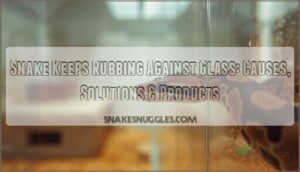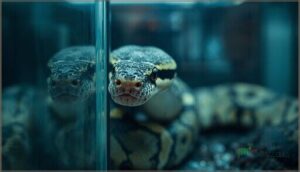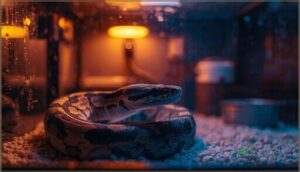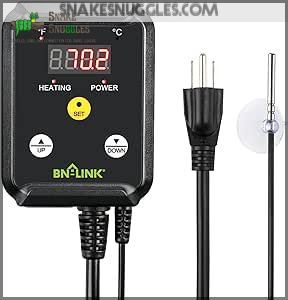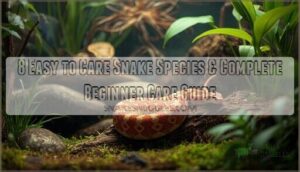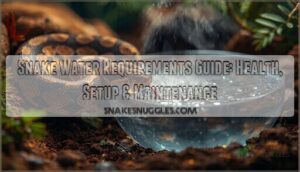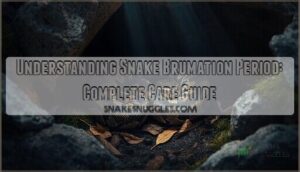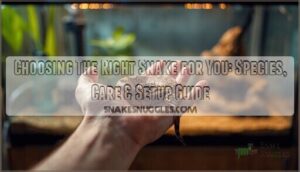This site is supported by our readers. We may earn a commission, at no cost to you, if you purchase through links.
Your snake presses its nose against the glass, slides along the sides, and won’t settle down. This behavior—often called glass surfing—isn’t random. It’s a signal.
Snakes don’t rub against enclosure walls for entertainment. They do it because something in their environment feels wrong. The trigger might be hunger, incorrect temperatures, or stress from feeling too exposed. Sometimes it’s a simple adjustment period after a move. Other times, it points to a husbandry problem that needs your attention.
Understanding the cause helps you fix the issue and keep your snake comfortable and healthy.
Table Of Contents
Key Takeaways
- Glass surfing signals specific environmental problems—hunger, incorrect temperatures (should be 75-85°F), inadequate hiding spots, or stress from reflections—that you can identify and fix rather than dismiss as random restlessness.
- Chronic glass rubbing damages your snake’s nose and scales while indicating deeper stress that weakens immunity and raises blood pressure, making quick intervention essential for both behavioral and physical health.
- Proper enclosure setup requires temperature gradients, at least two hiding spots (one warm, one cool), 3-4 inches of substrate for burrowing, and climbing branches to reduce stress-driven escape attempts by 47% or more.
- Most snakes stop glass surfing within 7-14 days once you address the root cause—whether that’s adjusting feeding schedules (juveniles every 4-7 days, adults every 10-14 days), covering reflective glass, or adding environmental enrichment.
Common Reasons Snakes Rub Against Glass
When your snake won’t stop rubbing against the glass, it’s not just restless—it’s trying to tell you something. This behavior usually points to specific problems in the enclosure that you can actually fix.
Let’s walk through the most common triggers so you know exactly what to look for.
Unfamiliarity With New Enclosure
When your snake first enters a new enclosure, confusion drives much of that glass-rubbing behavior. Your snake can’t understand the invisible barrier—it sees reflections, shadows, and movement beyond the glass and tries to reach them.
This environmental adjustment period triggers intense exploration as your snake seeks spatial familiarity. The stress usually fades within days as enclosure acclimation progresses naturally.
Providing adequate space for rectilinear behavior is essential for snake health.
Hunger and Feeding Triggers
Once your snake settles in, hunger often becomes the focus. You’ll notice heightened exploration, tongue flicking, and that telltale rubbing against glass—all hunting responses to feeding cues.
Hunger signals in snakes include:
- Increased activity during typical feeding times
- Mock strikes at movements near the enclosure
- Intense focus on you when approaching
- Repeated rubbing along enclosure walls
- Restless behavior before scheduled meals
Your snake’s digestive health depends on proper snake feeding schedules. Juveniles need meals every 4-7 days, while adults eat every 10-14 days. Missing these windows can trigger persistent glass-surfing as your snake searches for prey. Rapid tongue flicking indicates the snake is actively searching for food. Consistent snake diet management prevents nutrient deficiency and reduces stress-driven behaviors.
Incorrect Temperature or Humidity
Beyond hunger, environmental factors like temperature control and humidity levels can drive that constant glass rubbing. Your snake isn’t just restless—it’s telling you something’s off.
| Environmental Factor | Ideal Range | Signs of Stress |
|---|---|---|
| Temperature | 75°F-85°F ambient | Excessive rubbing, restlessness |
| Humidity | 60-80% (species-dependent) | Shedding issues, persistent glass-pressing |
| Thermal Gradient | Cool to warm zones | Inability to thermoregulate properly |
When climate regulation fails, your snake can’t thermoregulate. Prolonged thermal stress affects digestion, shedding, and triggers escape behaviors.
Monitor your snake enclosure with digital thermometers and hygrometers at multiple points—not just one spot.
Lack of Hiding Spots or Enrichment
If temperature and humidity checks out, take a hard look at your terrarium design. Naked, barren enclosures leave snakes exposed and vulnerable—triggering constant rubbing as they search for security that doesn’t exist.
- Environmental enrichment (branches, foliage, multiple hides) reduces stress-driven escape attempts
- Place at least two hiding spots—one on the warm side, one cool
- Cover encourages natural resting postures and decreases glass-rubbing behaviors
- Lack of visual barriers increases anxiety, especially in young snakes
Response to External Stimuli and Reflections
Why does your snake suddenly strike at thin air? Snakes rely on sensory cues more than reflection recognition—they can’t distinguish themselves in glass. External environmental cues like shadows or movement trigger territorial responses, intensifying glass surfing and stress.
| Stimulus Type | Snake Behavior |
|---|---|
| Reflections | Rubbing, striking at perceived intruder |
| Shadows/Movement | Increased enclosure pacing |
| External Noise | Heightened activity patterns |
| Lighting Changes | Behavioral conditioning responses |
Cover transparent areas to reduce reflection confusion.
Recognizing Stress and Discomfort in Snakes
Your snake’s behavior at the glass isn’t always simple curiosity—it can signal real discomfort that needs your attention.
Stress in snakes shows up in specific, recognizable patterns that tell you something’s wrong with their environment or health.
Let’s break down what these stress signals look like and what they mean for your snake’s well-being.
Signs of Stress and Escape-Seeking
Is your snake acting like an escape artist, constantly pushing against the glass? Glass rubbing often signals your snake is stressed and searching for a way out. You can spot these behavioral stereotypes by watching for:
- Repeated pushing or looping against enclosure sides and corners
- Hissing, striking at glass, or defensive behaviors when approached
- Rapid tongue flicking changes indicating environmental stress
- Physical damage like nose abrasions from persistent escape attempts
Elevated corticosterone levels drive these escape behavior patterns, revealing underlying stress factors.
Abnormal Repetitive Behaviors
Repetitive patterns tell you something’s wrong. When you see your snake performing the same movements over and over—rubbing identical spots, following exact paths—you’re witnessing stereotypy identification in action. These abnormal repetitive behaviors occupy up to 47% of a snake’s day, signaling captivity stressors and welfare indicators that demand attention.
| Behavior Pattern | What You’ll See | Why It Matters |
|---|---|---|
| Rigid glass surfing | Same route, same movements daily | Indicates poor enrichment efficacy |
| Corner fixation | Hours at one enclosure spot | Signals escape frustration |
| Unchanging loops | Identical paths repeatedly | Shows coping mechanism failure |
| Persistent rubbing | Constant contact despite changes | Requires behavior quantification |
| Barrier interaction | Undulating against transparent walls | Reflects inadequate snake care setup |
Standard enrichment often fails because these behaviors resist simple fixes—you need species-specific solutions rooted in natural history.
Impact of Chronic Stress on Health
Prolonged discomfort doesn’t just affect behavior—it attacks your snake’s body from within. Chronic stress triggers immune dysregulation, cardiovascular effects like elevated blood pressure, and compromised disease resistance. Mental health deteriorates as stress hormones flood their system.
Chronic stress doesn’t just change behavior—it weakens immunity, raises blood pressure, and breaks down your snake’s body from the inside
Poor enclosure conditions create societal burdens through increased veterinary costs and economic costs for treatments. Snake care that ignores these warning signs puts snake health at serious risk.
Territorial and Exploratory Actions
When your snake rubs against glass, it’s often exploratory behavior in action—a hardwired drive to investigate boundaries and resources. Without adequate enrichment, resource defense instincts and natural exploration get channeled into repetitive glass surfing.
This stimuli response increases after enclosure enrichment, with brain volume studies linking environmental complexity to cognitive engagement. Behavioral indicators like increased tongue-flicking signal your snake’s need for a more engaging enclosure.
Environmental and Husbandry Issues
Getting your snake’s environment right isn’t rocket science, but it does require attention to detail. When the basics like temperature, humidity, and enclosure setup are off, your snake will let you know through behaviors like glass surfing.
Let’s walk through the core husbandry factors that can trigger this behavior and how to fix them.
Proper Temperature and Humidity Regulation
Getting environmental conditions right is half the battle when your snake won’t stop glass surfing. You need proper temperature gradients—around 75°F to 85°F—so your snake can thermoregulate naturally.
Humidity monitoring matters too, since incorrect levels cause shedding difficulties and respiratory health problems.
Use thermostat calibration to maintain stable environmental factors. Without precise temperature regulation, your snake stays stressed and restless.
Importance of Enclosure Size and Design
Beyond temperature, your snake enclosure size directly affects glass surfing behavior. A cramped habitat triggers constant exploration attempts and welfare impact issues.
Minimum enclosure dimensions for healthy snakes:
- Length should match your snake’s full body length
- Width needs to be at least one-third the snake’s length
- Height matters for climbing species—don’t skimp vertically
- Design elements like gradients reduce stress behaviors
- Space enrichment decreases cost considerations from health problems later
Role of Substrate and Decor in Comfort
What your snake walks on—and what it interacts with—shapes its stress levels profoundly. Substrate depth of 3-4 inches facilitates burrowing behavior and humidity control naturally.
Decor variety means more than decoration: branches for climbing, hiding spots for security, and enclosure furniture that encourages snake enrichment. A perch or two allows weaving through spaces, reducing glass-rubbing urges considerably.
Maintaining Cleanliness and Reducing Reflections
Dirty glass tanks intensify reflections that confuse your snake, triggering rubbing behavior. Spot-clean daily using reptile-safe agents like F10 or diluted vinegar—never bleach. Deep-clean every 4-6 weeks, allowing surfaces to dry completely before reintroducing your snake.
Reduce reflections by applying matte backgrounds or adjusting lighting angles. These cleaning protocols and reflection reduction strategies directly decrease stress while supporting enrichment and natural behavior.
Addressing Hunger and Health Concerns
Sometimes your snake’s glass rubbing isn’t about the environment—it’s about what’s happening inside their body. Hunger can mimic stress behaviors, but so can underlying health problems you can’t see from the outside.
Let’s break down how to tell the difference and keep your snake healthy from the inside out.
Identifying Hunger Vs. Medical Issues
When your snake rubs against glass, is it just hungry or something more serious? Watch for feeding cues like increased tongue flicking and activity that resolve after eating—these point to hunger signs.
Medical checks become vital if you notice:
- Lethargy with refusal to eat
- Abnormal shedding or discharge
- Behavior persisting beyond feeding time
Health indicators like these demand veterinary attention to rule out respiratory issues or parasites affecting snake health.
Ideal Feeding Schedules and Diet
Generally, your snake needs whole prey every 7–14 days as an adult, but juveniles require feeding twice weekly. Prey size should match 1–1.5 times the head width to meet nutritional needs without regurgitation risk.
Adjust feeding frequency based on body condition—overfeeding leads to obesity, while proper snake feeding and diet prevents glass-surfing from identifying snake hunger.
Frozen-thawed rodents offer prey variety safely, and supplementation rarely becomes necessary with this feeding schedule and behavioral habit management.
Monitoring for Parasites and Respiratory Problems
When exactly should you suspect internal parasites or snake lung issues? Watch for open-mouth breathing, mucus discharge, or lethargy—signs your snake needs urgent veterinary guidance. Fecal analysis detects hidden infections before respiratory health deteriorates.
- Nearly 93% of captive reptiles harbor parasites undetected
- Respiratory infection symptoms often appear suddenly
- Parasite detection requires professional diagnostic methods
- Snake respiratory issues worsen without veterinarian intervention
- Early snake parasite control prevents life-threatening complications
Importance of Regular Veterinary Care
Your snake deserves annual wellness exams with a reptile specialist—these veterinary checkups catch hidden illnesses early, since snakes mask symptoms until problems escalate.
Preventive care through veterinarian visits identifies respiratory infections, parasites, and nutritional gaps before they threaten your pet’s life.
Medical diagnostics require expertise in snake health issues, making veterinary consultation essential for proper veterinary care and long-term well-being.
Top 4 Products to Reduce Glass Surfing
The right tools can make a real difference when you’re trying to calm a restless snake. From better temperature control to enrichment options, a few targeted upgrades often solve the problem.
Here are four products that address the most common causes of glass surfing.
1. REPTI ZOO 20 Gallon Terrarium Tank
A well-designed enclosure can stop face rubbing before it starts. The REPTI ZOO 20 Gallon Terrarium Tank offers solid material quality with tempered glass construction and proper ventilation design through its mesh top.
Tank dimensions of 24x18x12 inches give your snake room to move without feeling exposed. Assembly ease matters when you’re stressed about your pet’s behavior—this one goes together in five minutes.
Front-opening doors and safety features like secure locks reduce escape attempts while letting you maintain ideal enclosure conditions that minimize stress-related behavior.
2. Etekcity Infrared Thermometer Temperature Gun
Temperature accuracy is critical in reptile husbandry, as it can significantly impact the health and well-being of your snake. The Etekcity Infrared Thermometer utilizes infrared technology to measure surface temperatures across your enclosure without disturbing your pet. Its 12:1 distance ratio allows you to monitor basking spots and cool zones from several inches away, providing readings in just half a second.
This thermometer covers a wide temperature range, from -58°F to 1130°F, ensuring you can accurately assess your reptile’s environment. By using this tool, you can verify whether stress-related glass rubbing is caused by incorrect temperature or humidity levels, which are common issues in reptile care.
3. Digital Reptile Heat Thermostat Controller
A digital reptile heat thermostat controller takes the guesswork out of maintaining consistent temperature control in your snake’s enclosure. These devices use dimming technology to adjust heat output continuously, preventing the temperature swings that often trigger glass-surfacing behavior.
With accuracy within ±1°F, you can trust your thermostat settings to create stable environmental factors that support proper heat regulation. Digital displays make monitoring simple, while energy efficiency features reduce power consumption.
Most units handle up to 1000 watts, ensuring adequate reptile care regardless of enclosure size.
4. Natural Grapewood Vine Branch for Decor
Beyond temperature control, you’ll want to address habitat complexity with enrichment items like natural grapewood vine branches. These pet-safe decor pieces create climbing enrichment opportunities that reduce stress-related reptile behavior.
The textured surface provides grip for natural movement, while varied shapes add aesthetic enclosure design that breaks up glass reflections. By increasing vertical space and hiding spots, vine branch benefits include decreased glass-surfacing as your snake explores a more engaging enclosure.
Each piece offers unique contours that satisfy exploratory instincts without triggering escape behavior.
Frequently Asked Questions (FAQs)
Can snakes recognize their owners through glass?
Snakes rely on chemical cues and thermal sensing more than visual perception. While they may notice movement through glass, sensory limitations prevent true owner recognition—they can’t detect your scent or body heat through the barrier.
Does glass surfing harm a snakes scales?
Yes, persistent glass surfing can harm your snake’s scales. Repeated rubbing causes abrasions on the snout and belly, creating infection risk. Scale damage requires weeks to heal, making preventative measures and proper enclosure adjustments essential.
How long does typical glass surfing last?
Glass surfing usually lasts intermittently during a snake’s active hours—often a few minutes to several hours daily.
Most snakes reduce this behavior within 7 to 14 days as they acclimate, though stress indicators may prolong it.
Should I cover the glass to stop this?
Covering portions of the glass with opaque material acts as a visual barrier, reducing stress from reflections and external stimuli.
Partial coverage options help your snake feel secure while allowing you to observe behavioral changes and enclosure conditions.
Do wild snakes exhibit similar climbing behaviors?
Your snake’s glass-rubbing has absolutely nothing to do with climbing adaptations wild snakes use.
Natural behaviors involve scaling textured surfaces like bark, not smooth glass—captive vs. wild exploratory behavior differs completely.
Conclusion
Think of your enclosure as a silent conversation between you and your snake. When your snake keeps rubbing against the glass, it’s speaking—telling you something’s off.
You’ve learned to translate that language: check heat, add cover, adjust feeding, reduce reflection. Each fix is a response that says, “I hear you.”
Listen closely, act quickly, and that restless pacing fades. Your snake settles. The glass goes quiet. That’s when you know you’ve answered correctly.
- https://www.ingentaconnect.com/content/ufaw/aw/2020/00000029/00000004/art00002
- https://pmc.ncbi.nlm.nih.gov/articles/PMC8160691/
- https://www.reddit.com/r/ballpython/comments/120y7il/is_this_normal_i_got_a_new_snake_and_put_it_in_a/
- https://www.youtube.com/watch?v=50i_GXQso_g
- https://www.animalbehaviorandcognition.org/uploads/journals/26/AB_C_2020_Vol7(1)_Spain_et_al.pdf

